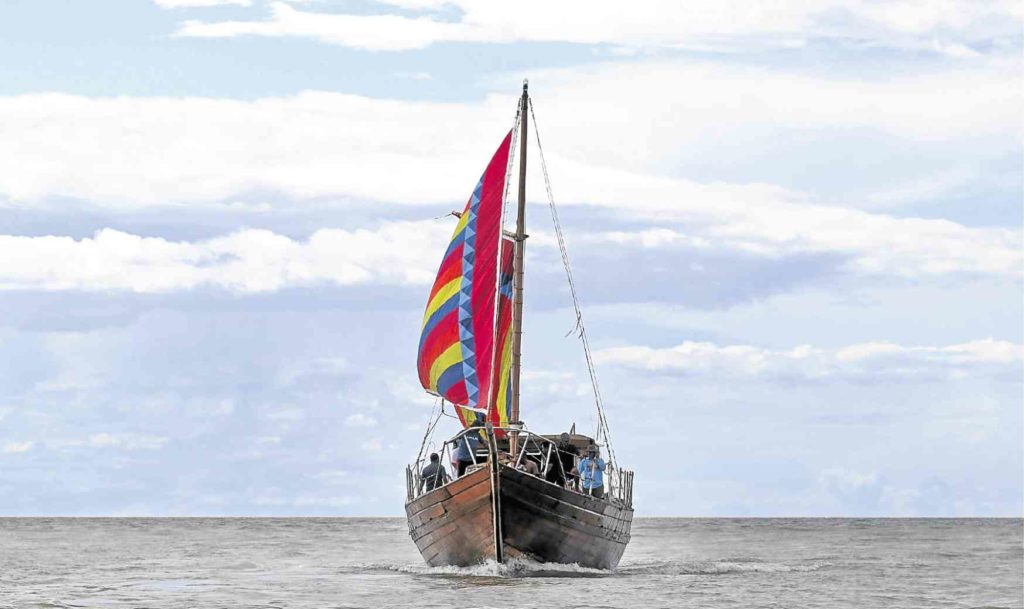China next balangay stop

GLORIOUS MARITIME PAST The Sama Tawi-Tawi, a balangay replica, sailing into Butuan City—ERWIN MASCARIÑAS JR.
BUTUAN CITY — A replica of a boat used by early Filipinos to trade with the rest of Asia stopped over here briefly to seek the blessing of “spirits” of mariners who, centuries ago, roamed the seas in search of trading posts and markets for goods.
The balangay, christened Sama Tawi-Tawi, would be part of a small fleet of balangay that would head for China along routes believed to have been used by Filipino seafarers hundreds of years ago.
Arturo Valdez, who commissioned the construction of Sama Tawi-Tawi, said the brief stopover was a significant stage in the journey of the balangay crew.
Something was missing
Valdez, who led the balangay Southeast Asian Voyage in 2010, said his team had been planning a trip to China since May last year “hoping to trace the old trading roots of the original balangay mariners.”
But the planned trip had been postponed several times.
“This made us believe that we are missing a significant blessing for our trip,” Valdez said.
“That is asking for the guidance of those who came before us,” he said.
The voyage to China was long overdue, Valdez said.
Bringing the balangay to Butuan Bay and Agusan River, Valdez said, was “an emotional journey.”
He said it was a homecoming for Sama Tawi-Tawi, which was built in Butuan City and went on its Southeast Asian journey from Agusan River.
Relying on sails
The balangay team hoped to reach Manila using mainly the boat’s sails and leave Manila with two other balangay replicas — Sultan Sin Sulu and Lahi ng Maharlika — on April 28 for Poro Point in San Fernando, La Union province.
From Poro Point, the balangay fleet would head for Xiamen.
Sama Tawi-Tawi was the biggest of the three balangay, although it now carried a small engine unlike before when it relied solely on wind to sail.
The two other balangay—Lahi ng Maharlika and Sin Sulu—were smaller.
Navigation skills would be key to the journey as “none of these ships were really built for an all-weather operation,” Valdez said.
Butuan find
Jody Navarra, of Butuan Global Forum Inc. (BGFI), said completing the journey to China was a “significant historic step for the entire balangay team that started in 2009.” BGFI raised funds to build a previous balangay, Mazau Hong Butuan.
The balangay replicas were built using patterns from remnants of original balangay that were unearthed in Butuan City in 1976.
Valdez said “it was from those boats that we had our inspiration to travel.”
His team, Valdez added, seeks to “prove to the rest of the world that our maritime trade heritage dates back further than what our colonizers had initially believed.”
Southeast Asian voyage
Navarra recalled that the first balangay replica, Diwata ng Lahi, left Manila on Sept. 1, 2009, for Butuan City, which had been considered to be home of balangay.
On Nov. 28, 2009, Diwata arrived in Butuan after passing about 54 ports nationwide. As Diwata neared Butuan, the other balangay, Mazau, was being built.
On Jan. 31, 2010, Mazau was launched and on Feb. 4, 2010, it and Diwata left Butuan for Sulu, Navarra recalled.
While Mazau and Diwata were passing by Zamboanga City, construction of Sama Tawi-Tawi began. On July 9, 2010, Sama Tawi-Tawi was finished.
In September 2010, all three boats left Tawi-Tawi for their Southeast Asian voyage, completing the journey that took them to Brunei, Indonesia, Malaysia, Cambodia, Thailand and Singapore.
Accidental discovery
A fleet of balangay was accidentally discovered by treasure hunters in 1976, drawing archaeologists from the Philippine National Museum.
The archaeologists took over the find and unearthed nine balangay.
In 2012, another balangay was found underneath a previously discovered boat, raising the number of discoveries to 10.
From discoveries made in the village of Libertad in Butuan, three balangay were unearthed and marked 1, 2 and 5.
Balangay 1 was dated back to 320 AD, Balangay 2 to 1250 AD and Balangay 5 to around 900 AD.
The late President Corazon Aquino on March 9, 1986, declared the three boats as national cultural treasures through Proclamation No. 86.
No more funds
Balangay 2 is now on display at the Maritime Hall of the National Museum in Manila.
Balangay 5 was displayed at the National Museum site in the village of Libertad.
After excavation resumed in 2012, only five balangay had been unearthed in the same two sites in Libertad. The most complete is now on display at the National Museum.
In 2014, shortage of funds suspended the excavation and digging for other balangay.
Work was stopped as right of way issues and questions on ownership of the land, where the excavation site was located, emerged.